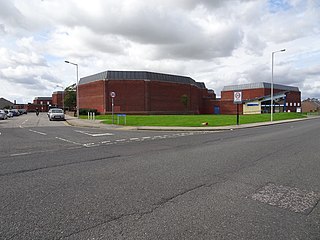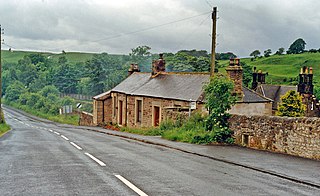
Briton Ferry is a town and community in the county borough of Neath Port Talbot, Wales. The Welsh name may indicate that the church, llan, is protected from the wind, awel. Alternatively, Sawel may be a derivative of Saul, St Paul's earlier name. He once landed at Briton Ferry. An alternative Welsh name unused today is Rhyd y Brython, a direct translation of Briton Ferry. The Normans referred to the River crossing as La Brittonne and Leland in 1540 as Britanne Fery.

Briton Ferry railway station is a minor station in the village of Briton Ferry, south Wales. It is 181.5 miles (292 km) from London Paddington. The station is located at street level at Shelone Road in Briton Ferry. It is a stop on the South Wales Main Line, served by Transport for Wales Swanline regional trains between Swansea and Cardiff.

Carmarthen railway station is on is on the West Wales Line serving the town of Carmarthen, Wales, south of the River Towy. The station is operated by Transport for Wales. Great Western Railway also run a limited service between Carmarthen and London Paddington, usually one train each way daily with additional services on Sunday.

Upper Boat is a village on the southernmost outskirts of the town of Pontypridd, within the electoral ward of Hawthorn, Rhondda Cynon Taf, Wales, and comprises part of the Treforest Industrial Estate. Historically part of Glamorgan, it fell within the parish of Eglwysilan.
The South Wales Mineral Railway was a railway built to serve collieries in the upper Afan Valley, and bring their output to a dock at Briton Ferry, in South Wales. It opened in stages, in 1861 and 1863. It was built on the broad gauge and had steep gradients, including a rope worked incline near Briton Ferry.
The South Wales Railway was a main line railway which opened in stages from 1850, connecting the Great Western Railway from Gloucester to South Wales. It was constructed on the broad gauge. An original aspiration was to reach Fishguard to engender an Irish ferry transit and transatlantic trade, but the latter did not materialise for many years, and never became an important sector of the business. Neyland was the western terminus of the line until 1906.
The Rhondda and Swansea Bay Railway was a Welsh railway company formed to connect the upper end of the Rhondda Fawr with Swansea, with the chief objective of transporting coal and other minerals to Swansea docks. It was incorporated in 1882, but at first the connection to Swansea from Briton Ferry was refused.

Penwyllt is a hamlet located in the upper Swansea Valley in Powys, Wales, lying within the Brecon Beacons National Park.
The Swansea District line is a section of railway line running through the northern part of Swansea, Wales and is primarily used for freight transportation, although minimal passenger services also traverse the route. It was built by the Great Western Railway in 1912 to provide a faster and less steeply graded route between London and Fishguard, in connection with the recently opened harbour at the latter place. It can thereby claim to be the last mainline railway to have been built in Wales. The double track line runs from Cwrt Sart junction at Briton Ferry on the South Wales Main Line to Morlais junction near Pontarddulais on the Heart of Wales line.

Peterhead railway station was a railway station in Peterhead, Aberdeenshire.

Cross Hands Halt railway station served Pilning, South Gloucestershire, England from 1928 to 1964 on the Severn Beach Line.

Greenhead was a former railway station, which served the village of Greenhead, Northumberland in Northumberland between 1836 and 1967.

Oakle Street railway station served the village of Oakle Street, Gloucestershire, England from 1851 to 1964 on the Gloucester-Newport line.

Braidwood railway station served the village of Braidwood, South Lanarkshire, Scotland from 1848 to 1962 on the Caledonian main line.

Bothwell railway station served the village of Bothwell, South Lanarkshire, Scotland from 1878 to 1955 on the Glasgow, Bothwell, Hamilton and Coatbridge Railway.
Court Sart railway station served the town of Briton Ferry, Wales, from 1895 to 1935 on the Rhondda and Swansea Bay Railway.

Briton Ferry Road railway station served the town of Briton Ferry, in the historical county of Glamorganshire, Wales, from 1863 to 1936 on the Vale of Neath Railway.
Briton Ferry East railway station served the town of Briton Ferry, in the historical county of Glamorganshire, Wales, from 1895 to 1935 on the Rhondda and Swansea Bay Railway.

Cerist railway station served the town of Llanidloes, in the historical county of Montgomeryshire, Wales, from 1873 to 1940 on the Van Railway.
West Cornforth railway station served the village of West Cornforth, County Durham, England, from 1866 to 1952 on the Great North of England, Clarence and Hartlepool Junction Railway.













